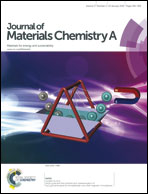Fluorine-substituted Mg(BH4)2·2NH3 with improved dehydrogenation properties for hydrogen storage†
Abstract
The F-substituted Mg(BH4)2·2NH3 was successfully prepared for the first time by mechanochemically reacting Mg(BH4)2·2NH3 and LiBF4 based on the structural and chemical similarity of [BH4]− and [BF4]− anions. The results indicate that the dehydrogenation properties of Mg(BH4)2·2NH3 are significantly improved by the partial substitution of fluorine for hydrogen. Hydrogen release from the F-substituted Mg(BH4)2·2NH3 is initiated at approximately 70 °C, which is an 80 °C decrease in comparison with the pristine sample. At 150 °C, the 15 mol% F-substituted sample releases ∼5.2 wt% of hydrogen within 40 min. However, only 1.2 wt% of hydrogen could be desorbed from the pristine Mg(BH4)2·2NH3 under identical conditions. Mechanistic investigations reveal that the B–H bonds in Mg(BH4)2·2NH3 are strengthened after F-substitution, which induces more ionised Hδ− in the ammoniate and consequently facilitates the local Hδ+–Hδ− combinations within the Mg(BH4)2·2NH3 molecule. In addition, the F-substitution weakens the Mg–B bonds in Mg(BH4)2·2NH3, which favours the generation of B–N bonds during dehydrogenation. These factors are the most important reasons for the improved dehydrogenation properties of F-substituted Mg(BH4)2·2NH3.


 Please wait while we load your content...
Please wait while we load your content...